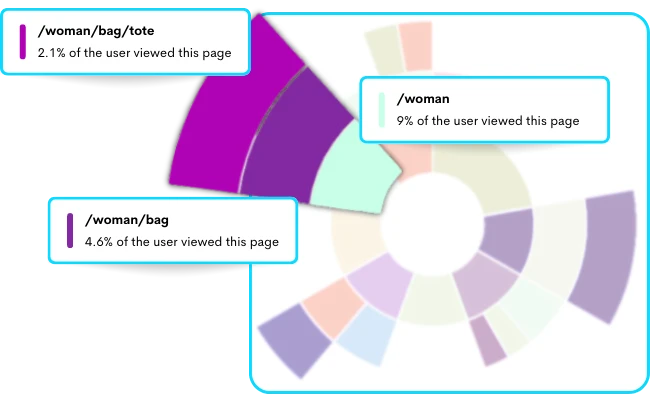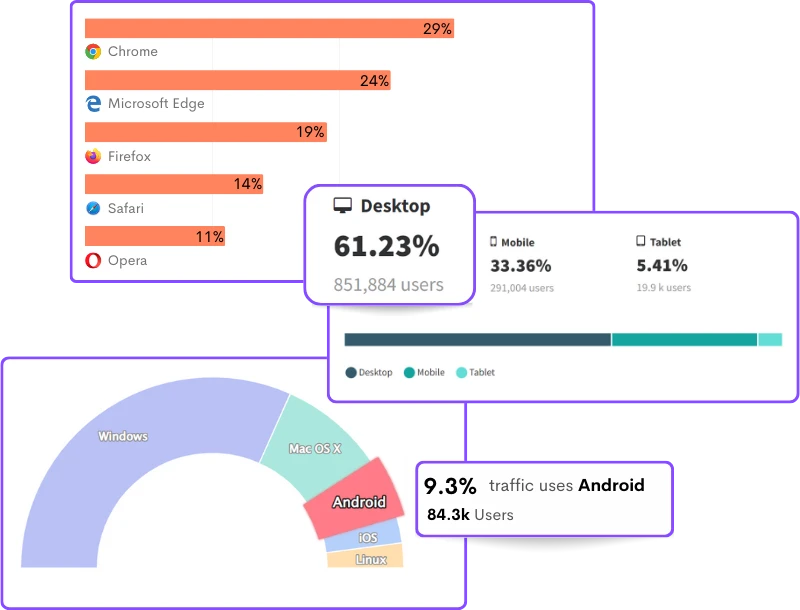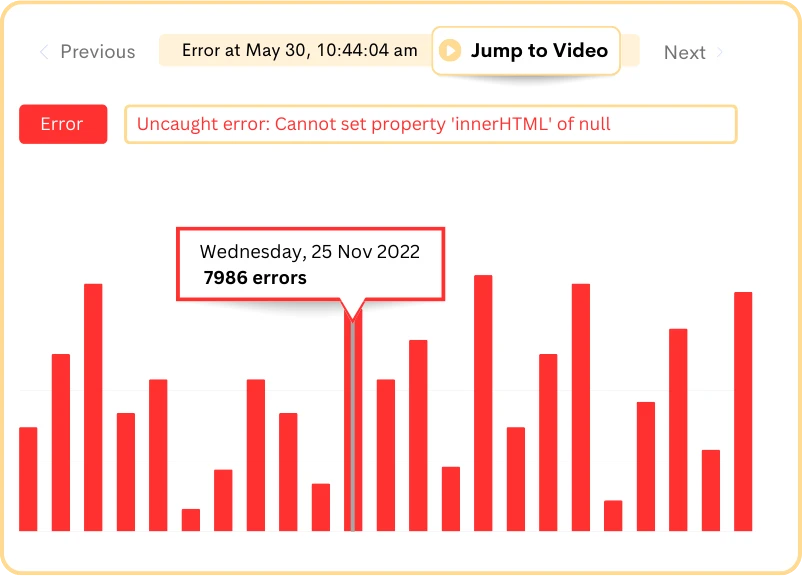
Digital Experience Analytics
Is your website failing to engage your customers? Gain deep insights into user behavior and preferences, optimize your digital channels, and enhance operational efficiency with ReplaybBird's DEA.
Benefits
 Save Time
Save Time Instantly capture and analyze behaviors as they happen in real-time.
 Enhanced User Experience
Enhanced User Experience Gain comprehensive customer insights for a complete understanding.
 Boost Revenue
Boost Revenue Identify emerging possibilities to drive revenue growth
 Customer Satisfaction
Customer Satisfaction Remove barriers and delight customers with effortless interactions.
 Pinpoint and Resolve Bugs
Pinpoint and Resolve Bugs Effectively address, troubleshoot, and resolve problems for prompt resolution.
 Privacy-Driven Integration
Privacy-Driven Integration Prioritize privacy and secure integration for driving continuous innovation.
Make the Digital Journey Seamless
Identify pain points in the user journey and optimize the user experience to reduce friction and increase conversions.

Boost User Interaction
Perform a holistic assessment of user navigation, search, and engagement with the digital platform to identify pain points and areas of friction that impact the user experience.
- Identify User Pain Points: Understand how users navigate, search, and engage with the platform.
- Optimize User Engagement: Identify which product pages generate the most engagement.
- Enhance User Loyalty: Understand how users interact with your digital channels to encourage repeat purchases.

Turn Every User Visit into a Successful Purchase
Uncover which product pages drive the highest engagement and identify those that lead users to exit.
- Identify Conversion Roadblocks: Assess user behavior and feedback to determine what influences conversion.
- Optimize Product Pages: Identify which elements, such as product descriptions, images, and reviews, have the most impact on user engagement and conversion.
- Personalize User Experience: Build stronger relationships with their customers, increasing the likelihood of repeat purchases and brand loyalty.

Leverage Operational Efficiency
Focus on issues based on your real-time business impact to target your resources and efforts on the most critical areas.
- Prioritize Technical Issues: Identify issues that are causing user frustration or impacting conversion rates.
- Streamline User Support: Create better self-service options and reduce the number of support tickets.
- Optimize Digital Marketing: Discover which marketing channels resonate to adjust your marketing strategy.
Frequently Asked Questions
It involves collecting and analyzing data from various sources, such as user interactions, website metrics, application logs, and network traffic, to gain insights into how users are interacting with digital experiences.
DEA enables businesses to understand the quality of the user experience, identify issues and areas of improvement, and make data-driven decisions to optimize the digital experience for their users.
By providing real-time insights into the user experience, DEA can help businesses to improve customer satisfaction, engagement, and conversion rates.
Firstly, users expect fast, seamless, and engaging digital experiences in today's digital age. If a website or application is slow, unresponsive, or difficult to use, users will likely abandon it and look for alternatives. Therefore, monitoring the user experience is crucial to ensuring digital experiences meet user expectations and keep users engaged.
Secondly, digital experiences are complex and involve multiple components, such as networks, servers, applications, and databases. Any issues or disruptions in these components can affect the user experience. DEA helps businesses to monitor and analyze these components in real-time, detect issues, and resolve them quickly before they impact the user experience.
Finally, the success of digital businesses depends on their ability to continuously improve the user experience and stay ahead of the competition. DEA provides businesses with valuable insights into how users interact with their digital experiences, enabling them to identify areas of improvement, optimize their digital experiences, and stay competitive in the market.
2. Data analysis: The collected data is analyzed to identify issues, such as slow page load times, errors, or broken links. The data is also used to understand user behavior, such as which pages users visit, how long they stay on the site, and which actions they take.
3. Alerting and reporting: DEA tools use advanced algorithms to detect issues in real-time and alert businesses to potential problems. The tools also generate reports and dashboards that provide insights into the user experience and highlight areas for improvement.
4. Optimization: Based on the insights generated by DEA tools, businesses can optimize their digital experiences to improve user engagement, satisfaction, and conversion rates. This may involve making changes to the website design, improving website performance digital, or addressing issues that are impacting the user experience.
Web Performance Monitoring is focused on monitoring and optimizing the technical performance of websites and web applications. This includes monitoring factors such as page load times, response times, and server performance digital. The goal of WPM is to ensure that websites and web applications are fast, responsive, and reliable, with minimal downtime and errors.
Digital Experience Analytics, on the other hand, is a broader concept that encompasses not only digital performance but also the user experience. DEA includes monitoring user interactions, user behavior, and user satisfaction levels, as well as technical performance metrics. The goal of DEA is to understand how users interact with digital experiences and to optimize those experiences to improve user engagement, satisfaction, and conversion rates.
WPM is a subset of DEA, focused specifically on technical performance digital, while DEA is a more comprehensive approach that also includes user experience monitoring and optimization.
2. Real-time issue detection: DEA tools use advanced algorithms to detect issues in real-time, enabling businesses to address them quickly and minimize the impact on users. By addressing issues proactively, businesses can prevent user frustration and improve customer loyalty.
3. Personalization: DEA tools enable businesses to collect and analyze data on user behavior, preferences, and interests. By using this data to personalize the user experience, businesses can improve user engagement and loyalty.
4. Competitive advantage: DEA tools enable businesses to differentiate themselves from competitors by providing a superior digital experience. By offering a more intuitive, seamless, and inspiring digital journey, businesses can improve customer loyalty and gain a competitive advantage.
2. Improved customer satisfaction: DEA helps ensure that users have a seamless and enjoyable experience on a website, which can lead to increased customer satisfaction. Satisfied customers are more likely to make repeat purchases and recommend the business to others, ultimately driving more revenue.
3. Reduced customer churn: Poor digital experiences can lead to frustrated users who may abandon a website or switch to a competitor. By monitoring and improving the digital experience, businesses can reduce customer churn and retain more customers over time.
4. Better insights into user behavior: DEA provides businesses with detailed insights into how users interact with their websites, which can inform decisions around product development, marketing, and other key areas. By leveraging these insights, businesses can better meet the needs of their users and ultimately drive more revenue.
1. Page speed: One of the key metrics monitored by DEA tools is page load speed, which is an important factor in SEO. Websites that load quickly tend to have higher search engine rankings than those that load slowly. By monitoring page load times, DEA can help businesses identify areas where improvements can be made to optimize their website's speed and improve its search engine ranking.
2. User experience: DEA tools also provide insights into the user experience of a website, which is another factor that impacts SEO. Websites that provide a positive user experience tend to have higher search engine rankings than those that do not. DEA can help businesses understand how users interact with their websites and identify areas where improvements can be made to enhance the user experience.
3. Mobile optimization: Mobile optimization is another important factor in SEO. DEA tools can help businesses monitor their website's performance digitally on mobile devices and identify areas where improvements can be made to optimize the website's mobile experience.
Stop guessing what your visitors want.
Playback everything visitors do on your site.
 Watch visitor behavior
Watch visitor behavior Watch movements of your visitor’s using session recordings.
 Notes, Segments and Tags
Notes, Segments and Tags Add notes, segments and tag to your recording for easy identification.
 Easy Installation
Easy Installation Installation is quick and simple using a javascript tarcking code.
 Performance monitoring
Performance monitoring Assess your site's user experience and uncover areas for improvement.
 Unlimited team members
Unlimited team members Invite all your team members and clients at no added cost!
 Block IPs
Block IPs Exclude tracking yourself, your team or clients by blocking their IPs.
 Share
Share Share notes and website recordings to your fellow mates.
 User Identify
User Identify Track users to identify which users are having bad user experience.
 Audit Logs
Audit Logs See security audit logs for your projects and accounts.
Start using ReplayBird for free now.
Understand your customers in real-time.
Replace Assumptions with User Journey Insights
Identify potential opportunities to increase productivity and profitability, leading to more effective and cost-efficient outcomes.

Customer journey mapping analytics shows how visitors progress on your site from entry to exit.

Record website visitors’ mouse movement, clicks, taps, and scrolling across multiple pages.

Bring your users to the right product with ReplayBird to boost Inter-Functional Collaboration.

Monitor every page on your site, rectify the issues, and enhance customers' better experience.

Discover all the front-end issues that occur in your web application before your customer notices them.

Get a complete overview of the multiple points of impact from your website’s performance.

It's the method analyzing a user's journey through a series of events that lead up to conversion.

Form Analysis helps you understand how your forms are performing, by analyzing user behavior interactions.

Keep digital records of web and mobile interactions. Securely retain relevant digital records.

Understand the quality of your user experience to deliver a more intuitive and inspiring digital journey.

Digital accessibility means ensuring the web is accessible by everyone, which is a moral imperative.

ReplayBird offers exceptional user data security, purpose-built for privacy, security and compliance.